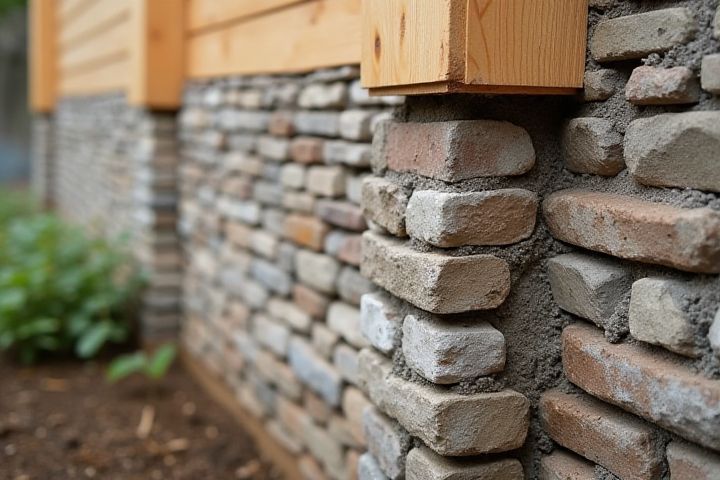
Regularly inspect your foundation for signs of cracks, shifting, or water damage, as these can indicate underlying issues that need immediate attention. Proper drainage around your home is essential; ensure gutters and downspouts direct water away from the foundation to prevent moisture accumulation. Monitor soil moisture levels, particularly during dry spells or heavy rainfall, as consistent soil moisture helps maintain foundation stability. Consider landscaping with proper grading to promote water runoff and reduce erosion near the foundation. Additionally, maintain your heating and cooling systems to prevent extreme temperature fluctuations, which can affect the foundation's integrity.
How To Maintain A House Foundation
Ensure proper drainage
Proper drainage is crucial for maintaining a house foundation, as it helps prevent water accumulation around the base. Install gutters and downspouts that direct water away from the foundation, ideally at least 5 to 10 feet from the structure. Regularly inspect and clear any debris from your drainage systems to ensure they function effectively. You can also incorporate grading around your property, sloping the ground away from the foundation with a minimum drop of 1 inch for every 4 feet to enhance water runoff.
Monitor soil moisture levels
Regularly monitoring soil moisture levels around your home's foundation is essential to prevent structural issues. Use a moisture meter or perform manual checks to ensure the soil remains consistently damp, avoiding extremes of dryness or saturation. Adequate moisture helps maintain soil expansion and contraction, reducing the risk of cracks and settling. Implementing proper drainage systems, such as gutters and downspouts, can further regulate moisture levels, enhancing your foundation's longevity and stability.
Regularly inspect for cracks
Regular inspections for cracks in your house foundation are crucial for maintaining structural integrity. Look for horizontal or vertical cracks wider than 1/4 inch, as these may indicate significant issues. Be vigilant for signs of water damage or shifting soil in your yard, which can also impact the foundation. Schedule these inspections at least biannually to catch potential problems early and protect your home's value.
Maintain trees and shrubs
Maintaining trees and shrubs near your house is crucial for preserving your foundation's integrity. Keep the roots of these plants at least 10 feet away from your foundation to prevent soil disruption that can lead to settling or cracking. Regularly prune overgrown branches to minimize moisture accumulation around your home, which can create problems like drainage issues or pest infestations. Monitor rainfall and adjust your irrigation practices to ensure your landscape does not contribute to excessive soil moisture near the foundation, ideally keeping it at a balanced 25-30% moisture level.
Keep gutters clean
To maintain your house foundation, ensure your gutters are clean and free-flowing, as clogged gutters can lead to water pooling near the foundation. Regularly inspect your gutters for debris, especially during the autumn months when leaves fall, and consider using a gutter guard for added protection. Aim to clean your gutters at least twice a year, or more frequently in regions with heavy rainfall. Keeping gutters clear of blockages can prevent moisture issues, reducing the risk of costly foundation repairs that can be upwards of $2,000 to $10,000.
Level the foundation structure
To maintain a level house foundation, regularly inspect for signs of settling, such as cracks in walls or uneven floors. You can utilize a carpenter's level or laser level to check the foundation's flatness, aiming for a variance of no more than 1/4 inch over a 10-foot span. If you notice significant shifting, consider hiring a professional foundation contractor to assess and implement pressure stabilization techniques, such as piers or underpinning. Ensure proper drainage around your foundation by maintaining gutters and downspouts, directing water away from the structure to prevent future issues.
Use proper landscaping
Proper landscaping plays a crucial role in maintaining your house foundation, as it directs water away and minimizes soil erosion. Ensure that the ground slopes away from your home by a minimum of 6 inches within the first 10 feet; this helps prevent water accumulation around the foundation. Planting trees and shrubs at least 10 feet from the foundation can also mitigate risks, as their roots will not disturb structural integrity. Regularly inspect drainage systems and utilize mulch in garden beds to retain soil moisture without saturating the foundation area.
Avoid excessive water near foundation
To maintain your house foundation, it is crucial to manage water drainage effectively, as excessive water can weaken the structure. Ensure that gutters and downspouts direct water at least 5 to 10 feet away from the foundation to prevent pooling. Installing a French drain or landscaping with sloped soil can also help redirect rainwater away from your home, reducing the risk of foundation damage. Regularly inspect and maintain these drainage systems to keep your foundation secure and prevent costly repairs.
Insulate against moisture
To insulate your house foundation against moisture, ensure proper drainage around your property by grading the soil to slope away from your foundation. Installing a waterproof membrane on the exterior walls of your foundation will prevent groundwater from seeping in, protecting against dampness. Use high-quality insulation materials like closed-cell spray foam, which provide moisture resistance, preventing mold and rot. Regularly inspect and maintain gutters and downspouts to ensure they are clear and divert water at least 5 feet away from the foundation.
Schedule professional inspections
Scheduling professional inspections for your house foundation is essential to ensure its integrity and longevity. Experts recommend having these inspections annually, especially in areas prone to extreme weather conditions or fluctuating soil moisture levels, which can cause settlement issues. During a foundation inspection, professionals assess for cracks, uneven surfaces, and signs of water intrusion, which can indicate potential problems. Regular inspections help you address any concerns early, potentially saving you thousands in repairs and maintaining your home's overall value.
